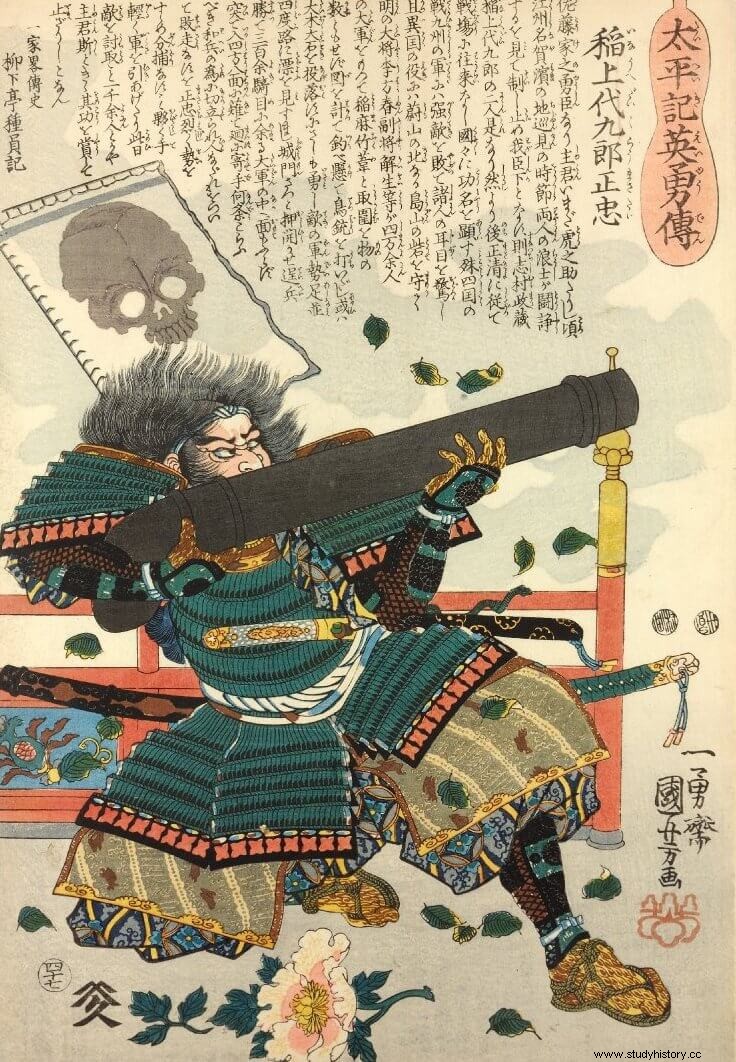
Inazo Nitobe wrote his famous study of Bushido in 1900 . It said:
Honorable, austere and traditionalist, apparently the samurai they have nothing in common with the firearm. The truth, as always, is somewhat less colourful:for years Nitobe tried to prevent his work from being translated into Japanese out of sheer fear of the criticism that his extremely romantic vision of the Japanese past would receive [2]. Q>
The truth is that Japan adopted the use of gunpowder for military purposes somewhat late:the Chinese already used cannons and explosives during the Jin and Song dynasties, in the 13th century, while that portable and even personal firearms began to be used in Europe at the end of the 14th century, and their use became widespread at the end of the 15th century.
However, the Japanese soon understood the enormous potential of firearms and they adopted it enthusiastically practically as soon as they met them. Some fiefdoms such as Satsuma in southern Japan are believed to have imported firearms from Siam in present-day Thailand,[3] and the wako is known to (see "The Scourge of the wako. Japanese piracy» in Desperta Ferro Antigua y medieval No. 6), which devastated the Chinese and Korean littoral, used them, but the most widespread account maintains that the Japanese knew of these weapons in 1543 when two Portuguese merchants were shipwrecked aboard a Chinese junk off the coast of Tanegashima, in Kyûshû .
Ruffian weapon or prestige item?
The daimyo – feudal lord of the place – Tanegashima Toritaka, was interested in an artifact with which the leader of the expedition, Fernão Mendes Pinto, had shot down a duck in his presence:the daimyo agreed with the Portuguese to buy the two arquebuses that the expedition was carrying, as well as to receive lessons on their use[4]. Toritaka ordered one of his vassals to learn how to make gunpowder for the weapon and several gunsmiths to learn how to make the weapon, without success:fortunately for him, the following year the Portuguese returned, so Toritaka took the opportunity to procure the services of Portuguese instructors who teach him how to make the weapon.
By 1545 Toritaka had already managed to produce several dozen arquebuses, or teppô , and the technique had already been exported to the port city of Sakai, near Osaka, one of the great commercial enclaves of the archipelago, from where it would spread to the rest of Japan.
The novelty of the teppô soon gave it a prestige weapon status , which would explain why the Teppô ki , the chronicle of the arrival of the Portuguese in Tanegashima, ignores the fact that they arrived on the island aboard a Chinese junk captained by Wu-Feng, a notorious Chinese merchant and smuggler, and describes the two Portuguese adventurers simply as "leaders of the merchants."[5] The Teppô ki thus putting a weapon worthy of lords in the hands of foreign leaders and not pirates and outlaws, thus justifying its power and giving it the status of a prestige object .
This valuable artifact was often used as a gift or as a favor between clans, who secretly required it as a token of friendship in order to copy it and incorporate it into their arsenals:in the first years after its arrival was usual for a clan to offer it as a token of friendship to another clan with whom it wanted to maintain an alliance; In the same way, it was also common for European merchants to give one of these weapons as a gift to the authorities of the local fief to enjoy their hospitality, a practice that Christian missionaries in Japan would also resort to and that would partly explain the interest of various clans of Japan in Christianity.

This circulation meant that by the end of the decade, six years after the arrival of Mendes, most of the great clans of Kyûshû already knew the teppô otanegashima , as it was also known by its place of origin. The Shimazu clan of Satsuma, one of the island's great clans, began using Portuguese-made arquebuses in 1549, and in 1548, Murakami Yoshokiyo, a member of the Murakami family, notorious pirates among other things, used it when he fought in the service of the Uesugi at the Battle of Uedahara in 1548, which was the first battle in Japan to use large-scale firearms (see volume 3 of Samurai Saga ). The Murakami managed to become a serious threat, which helped make teppô popular. :the Hosokawa acquired the weapon in Kyoto around 1550 and around the same time the shogun Ashikaga Yoshiharu himself would acquire it, having armory workshops in Satsuma, Hizen, Bizen, Tosa, Chôshû, Sakai or Kishu.
The Oda clan, one of the clans that tried to unify Japan, saw the potential of the weapon:around 1549 Oda Nobuhide, daimyo Oda, ordered an order for five hundred arquebuses, the largest order made to date.[6] Another grand daimyo, Takeda Shingen de Kai, archenemy of the Murakami, acquired in 1555 two hundred teppô to attack a castle. He was so satisfied with the result that he decided to acquire another five hundred to garrison one of his castles, and in 1569 he wrote:
The samurai and the teppô
However, the specs of the arquebus they were far from ideal:with their eleven kilos, to which ammunition, fuse and gunpowder had to be added, the teppô it was inaccurate, slow to reload, and had a low rate of fire:an experienced marksman could fire two, maybe three shots per minute[8], time in which an archer could fire fifteen arrows,[9] not to mention that it had a long range. less than a hundred meters, which was reduced to about fifty if the target was minimally protected. Furthermore, the water rendered it useless, as did the humidity, a notable drawback given Japan's insular nature and humid climate. However, the arquebus also had its own advantages, the main one being that it was relatively easy to operate and dozens of individuals could be taught how to shoot it in only a fraction of the time it took to teach how to use a bow. /P> 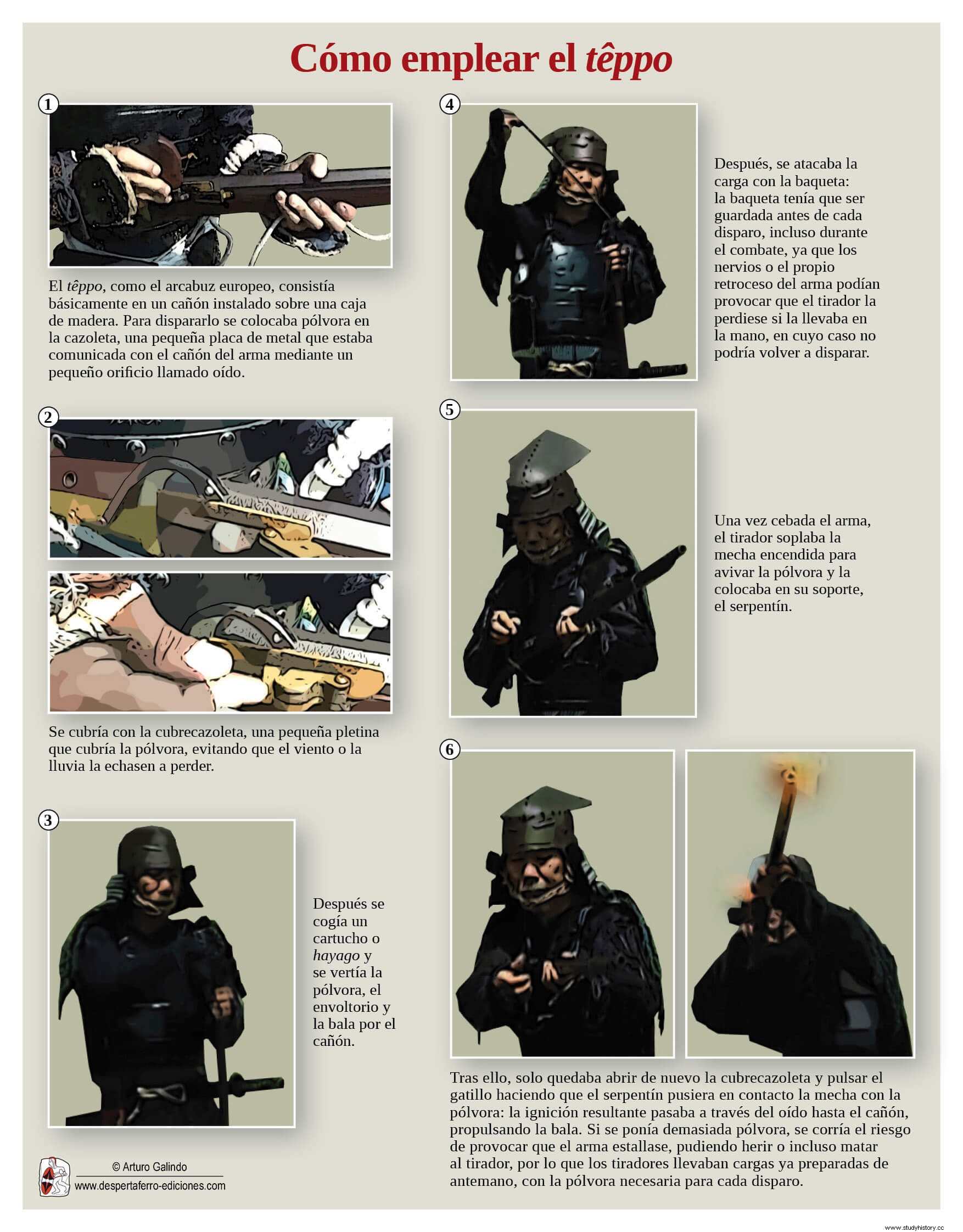
The original design of the teppô it was soon improved to be able to be fired in spite of the rain, and by 1575 Japanese armies, like Europeans, had learned, like Europeans, to coordinate large bodies of troops armed with firearms to fire while covering the reloading of their comrades. , achieving a continuous rate of fire:in many cases the troops armed with bows, which were decreasing in number, were used to cover with their shots the troops armed with arquebuses while they were reloading.
The Japanese gunsmiths they had managed to produce several formats of firearm, coming to design arquebuses but also carbines (bajotutu ) and pistols (tantutu ) adapted to be used on horseback, which allowed many samurai who fought on horseback to have a version of the weapon suitable for equestrian combat. In addition, they also managed to unify the criteria regarding calibers, which standardized the manufacture of the weapon on a large scale and made it easier to acquire ammunition, regardless of whether they were used in imported weapons or brought from abroad. The teppô usual had a caliber between two and two monme and a half (9.5-12 mm) and weighing about eleven kilos:to this basic model were added others with a caliber of five monme (15mm), ten monme (17 mm and 27 kilos), thirty monme (26mm) fifty monme (35mm) and even 100 monme (42 mm);[10] these weapons caused such a great recoil that they were generally used as cannons and sacks of rice had to be placed behind the shooter to absorb the recoil.
The samurai incorporated the teppô to his arsenal adapting it to his way of waging war. This one was simple:in the bars leading up to battle, he'd call out his name and challenge someone from the opposing side. Once someone accepted the challenge, both would ride against each other and shoot arrows until one of the two fell and the winner claimed his head. His troops could withdraw or try to avenge him, clashes taking place along the battle line, depending on the result of the various duels that had taken place.
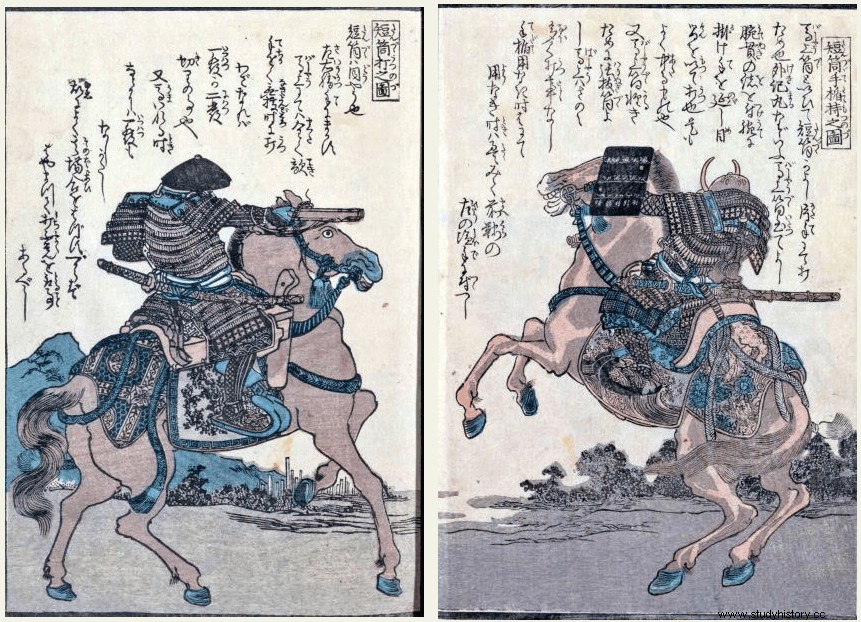
The problem, then, for the samurai was not an aversion to shooting:it was more to adapt this archaic genre of combat to a model of mass warfare in which the advance and fire of large contingents of troops (a dynamic favored by the firearm) made such an individualized genre of combat unfeasible. The teppo The common one with which the arquebusiers were equipped reduced him to one more piece of that line, to a common soldier:the samurai needed something more special, so he adopted the teppô to his way of waging war.
That is why he often opted for the teppô large caliber u ôzutsu . This is how they are represented in several cases:various 19th-century scenes of ukiyo-e document important samurai of the invasion of Korea carrying these weapons, implying that it was an acceptable practice for their status, even Yoshitoshi illustrated the case of a crime boss, Seiriki Tamigoro, committing ritual suicide, not by means of a sword, as would be expected, but shooting himself with an arquebus in his mouth by activating the trigger with his feet. The predilection on the part of the samurai for this type of weapon is due, first of all, to the fact that only they could afford the high cost of these weapons, unlike the bulk of the armies, which were equipped with standardized versions of two monme; because, secondly, these heavy weapons had the function of acting against fortifications, against enemy ships or even against entire infantry formations, thus providing the samurai who carried them with the element of single combat that he so much sought. The samurai armed with a 30-kilogram weapon that fires metal projectiles the size of an orange was not averse to using a firearm, but rather sought to adapt it to his personal way of waging war, focused on the pursuit of personal glory:that personal glory did not lie in using his weapon massively like the rest of the infantry but in unique weapon feats, such as using his powerful ôzutsu to fire at an entire ship, a fortification, or to eliminate enemy commanders.[11]
Towards the end of the century with the civil wars nearing their end, Japanese armies were fielding a number of firearms comparable to what could be seen in any battle in Europe:when Japan invaded Korea in 1592 , the army that the Shimazu brought from Satsuma consisted of 1,500 archers, 1,500 arquebusiers, and 300 spearmen, while hatamoto's retinue , or direct vassals, of the daimyo Date Masamune was composed of 100 arquebusiers, 100 spearmen and 50 archers. The army that the Dates fielded eight years later consisted of 420 mounted samurai, 200 archers, 1,200 arquebusiers, 850 spearmen, and 330 reserve troops.[12]
The testimonies of those who participated in the Korean War are eloquent:Shimazu Yoshihiro, daimyo Shimazu, wrote in 1592 from Korea “Please try to send us firearms and ammunition. There is no need for spears at all”,[13] while Asano Nagamasa, a samurai commander, wrote to his father “have them bring as many firearms as possible, as there is no need for other equipment […] give strict orders that all men, even samurai, carry firearms.”[14]
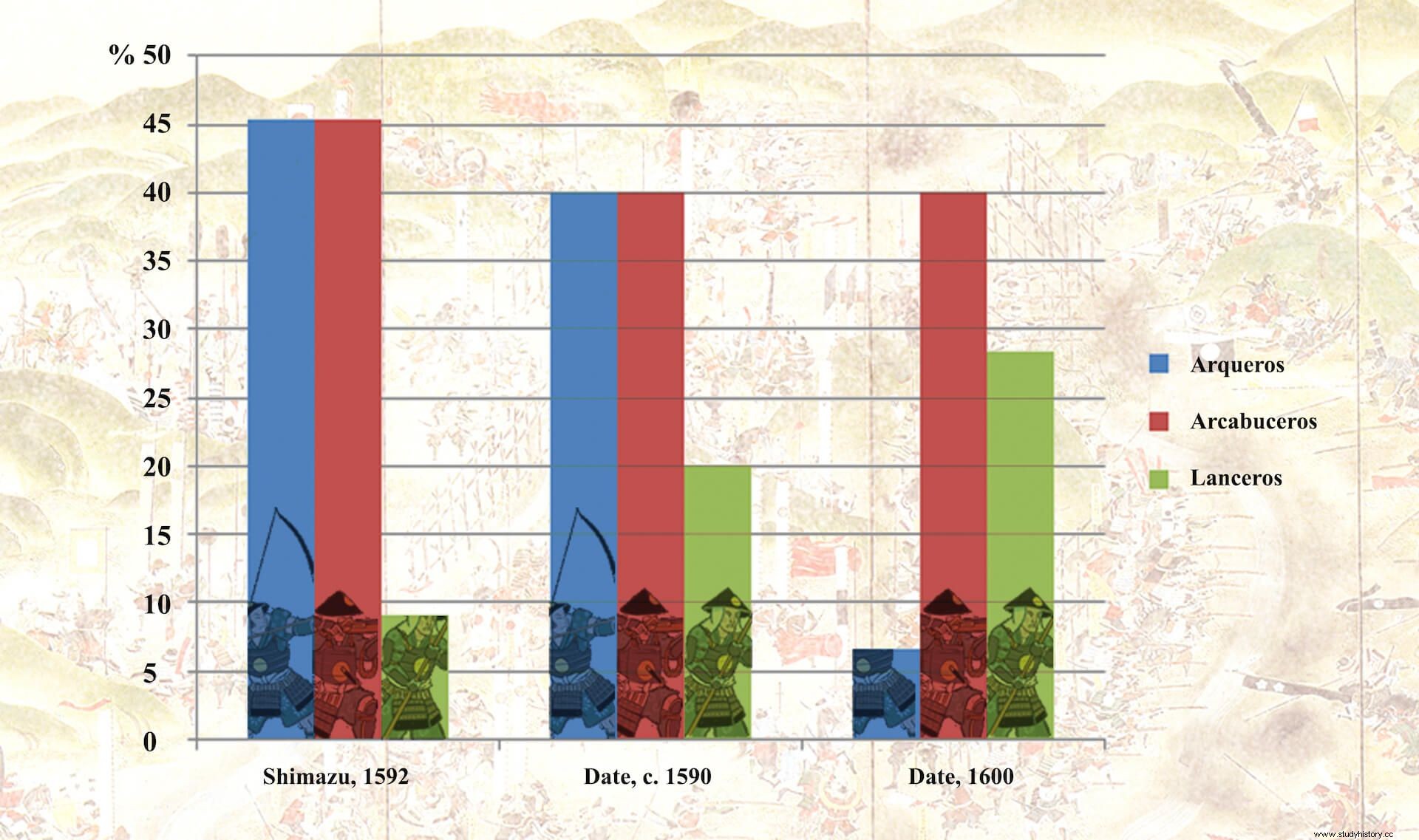
In fact, the Japanese got along so well with them that the Koreans decided to learn from them as soon as they were able to reject them back to Japan. The Korean king, Seonjo, ordered “hurry to master the manufacture of arquebuses. We are not yet able to make gunpowder. Do not kill the Japanese who know how to do it. Make them teach us.”[15]
Of course, by then Japan had been going through a violent period of civil war:it made sense to produce firearms. According to the same Mendes Pinto who brought the weapon to Tanegashima, there were more than three hundred thousand firearms in Japan at the time.[16]
Teppo , a state weapon
In 1603 the clan of the Tokugawa of Kanto gain control of Japan, establishing themselves as shoguns. The civil wars were over and there would no longer be any great battles with which the teppô it was no longer necessary. To some extent, since firearms disappeared with peace?
In 1588 the authorities understood that any disturbance could threaten the stability of the country if the population had weapons within their reach, so an edict was promulgated which prohibited to all no samurai have weapons . This edict was renewed in 1607, and in 1625 Ieyasu, the first Tokugawa shogun, would carry out similar measures on firearms, forcing all gunsmiths to settle in Nagahama, by Lake Biwa:if they were all together, it would be more It was easy for the Tokugawa authorities to keep an eye on how many weapons they made and for whom they were made, so to ensure that they did not sell their wares to dissident figures, the Tokugawa assigned these gunsmiths pensions as well as keeping them busy with somewhat exclusive requests from time to time. , either for the arsenals of the shogun or for ceremonial use through a "magistrate of firearms", the teppô bugyô. [17]
The authorities carried out military reviews (jôran ) periodic meetings of the daimyo contingents, in which they tested their performance in various areas, among which was always shooting and in which the prize for the good shot or the host daimyo was often again a weapon specially made for the chance. Shogun Ieharu himself was celebrated as a master of "the pen and the sword" for the fact that he had mastered Chinese literature, but also archery, horsemanship, and shooting.[18] The fact that he saves her ritually (teppô hajime ) was incorporated around 1620 by the shogun Hidetada into the New Year ceremony[19] gives an idea of the extent to which these weapons were important for a State whose idiosyncrasy was eminently military.

By 1625 four families of teachers were concentrated in Nagahama gunsmiths, as well as another forty lesser gunsmiths engaged in the manufacture of firearms, usually commissioned by the Edo government or some authorized daimyo. The Edo authorities took advantage of the climate of peace to request somewhat more exotic weapons, such as pistols or new flintlock rifles or large-caliber experimental pieces, intended either as protocol gifts or for study.
The daimyo kept private arsenals prior license from the Tokugawa and continued to study the use of teppô in several shooting schools uhojutsu who elaborated treatises on shooting and the manufacture of these weapons:between 1608 and 1621 alone, 72 volumes and rolls were produced by eight different schools on the manufacture of firearms, ammunition, parts and on their use[20] destined for train sharpshooters, or hojutsushi .
All this production was commissioned and consumed by the shogun and the daimyo themselves who tried to keep those weapons and continue to be skilled in their use, since somehow knowing and disposing of weapons of fire showed that they were capable of arming armies and that, despite the good life, they continued to be military lords. It was their way of saying that although there was no longer a war, they were still warriors.
There were other cases in which the firearm continued to be used on a daily basis . Rural dwellers, for example, used to obtain licenses that allowed them to keep firearms on loan from the daimyo or borrow them during the harvest months to protect their fields from wild boars, wolves, and other animals (odoshi teppô ) or to hunt (ryôshi teppô ):[21] Sometimes the license to transfer these weapons was inherited from father to son.
On exceptional occasions, a license could also be issued in favor of an individual that would allow him to have a firearm for his defense ( yôjin teppô ). However, they were rare cases:the Tokugawa period, or Edo period , was the time par excellence in which the sword became the weapon of daily use. It was at this time that all the mythology around the sword was created and when it became the most visible weapon. The clashes changed from battles between armies to skirmishes between swordsmen.
If firearms ceased to be used, it was not because they were not studied, manufactured or appreciated. It was simply because, in a street fight in the Edo period, a firearm such as those known in Japan was not practical:it took at least twenty seconds to reload the weapon, and that is assuming that the weapon already had its fired and ready. wick:otherwise you had to light a fire, light the wick, fan it and place it in the coil:the teppô it was useful for big battles in which the shooter arrived with the weapon ready in time and in which he only had to worry about shooting a compact mass of men.
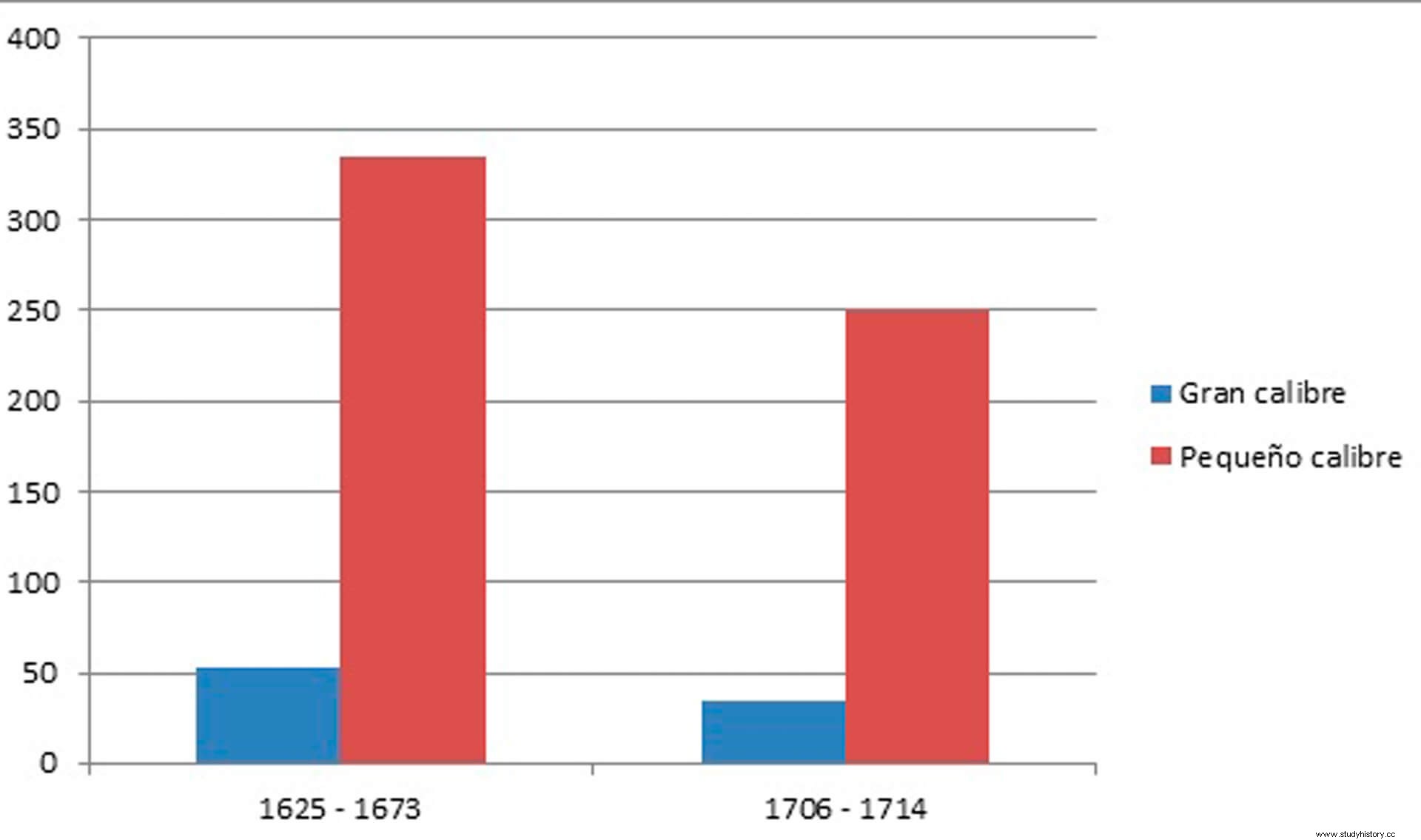
But there were no such battles in Japan anymore. The arquebuses were now studied, kept in armories, displayed in processions and ceremonial parades, but were rarely used anymore. Since the central government established a monopoly on the production of firearms in Nagahama in 1625, production has dropped from 53 large-caliber and 334 small-caliber arquebuses ordered between 1625 and 1673 to 34 large-caliber and 250 small between 1706 and 1714.[22]
It was not until the 19th century that interest in firearms was renewed:when the Japanese met the Western colonial powers they quickly reverted to adopting their weaponry. If this was not possible, they tried to modify their old arquebuses to become percussion or even bolt action rifles. But Japan would not spend another three centuries depending on relics:as then, it quickly embraced new technologies and modernized itself, but in a way that this time would not be circumstantial but permanent.
Notes
[1] 147, Nitobe, Inazo, Bushido:The Code of the Samurai , 2002, Obelisk Editions, Barcelona.
[2] 157, Benesch, Oleg, Bushido:The Creation of Martial Ethic in Late Meiji Japan , 2011, University of British Columbia, Vancouver.
[3] 28, Reconstructing the Japanese Men , Frühstück, Sabine &Walthall, Anne, 2011, University of California Press, Los Angeles.
[4] 92, Turnbull, Samurai and the Sacred .
[5] 28, Reconstructing the Japanese Men , Frühstück, Sabine &Walthall, Anne, 2011, University of California Press, Los Angeles.
[6] 74, Samurai Warfare Dr. Stephen Turnbull 1996, Arms and Armor Press, 1996, London. However, by 1549 Nobunaga was not yet a daimyo, having had his genpuku in 1546.
[7] 74, Samurai Warfare Dr. Stephen Turnbull, Routledge Arms and Armor Press, 1996, London.
[8] 116, War in the Modern World 1450-1815 , Jeremy Black (ed.), Routledge, 2005, London.
[9] Perrin, Noel, Giving up the gun , 5, 1988, D. R. Godine, Boston in "Arquebus in Japan", Richardson Michael in The Concord Review , 2011, Will FitzHugh, Sudbury, 191.
[10] 25, Japanese Castles in Korea , Turnbull, Stephen, 2007, Osprey Publishing Limited, Oxford.
[11] Turnbull. Stephen &Gerrard, Howard, Ashigaru 1467-1649 , 18 in "Arquebus in Japan", Richardson Michael in The Concord Review , 2011, Sudbury, 194.
[12] 70, Samurai Warfare Dr. Stephen Turnbull, Routledge Arms and Armor Press, 1996, London.
[13] 25, Japanese Castles in Korea , Turnbull, Stephen, 2007, Osprey Publishing Limited, Oxford.
[14] 220, The Samurai:A Military History, Turnbull, Stephen, Routledge Curzon, 2005, Oxon.
[15] Annals of the Joseon Dynasty, Year 26, March 11.
[16] 30, Inoguchi, Takashi, Japanese Politics:an Introduction , Trans Pacific, 2005, Victoria.
[17] 80, Richard J. Samuels, “Rich Nation Strong Army”:National Security and the Technological Transformation of Japa n, Cornell University Press, 1994, New York.
[18] 41, Displaying authority:Guns, political legitimacy and martial pageantry in Tokugawa Japan, 1600-1868 , Daniele Lauro, University of North Carlina, Chapel Hill, 2012.
[19] 41, Displaying authority:Guns, political legitimacy and martial pageantry in Tokugawa Japan, 1600-1868 , Daniele Lauro, University of North Carlina, Chapel Hill, 2012.
[20] Uda Nagatonokami Suekage's “Book of Secrets of Uta”, from 1608, the two copies of Inatomi Ichimu Risai's “Book of Secrets of the Inatomi School”, of eleven and twenty volumes, from 1610, Makimura Yasaku's "Scroll of Secrets of the Firearm" from 1612, Koizumi Kinosuke's "Book of Secrets of the Southern Barbarians" from 1612, the "Book of Teachings of Toten ” by Suzuki Kyubee from the same year, Tsuda Kenmotsu Shigenaga's “Book of Sources, Secrets and Targets” from 1615, Tatsuke Sotetsu's Kyuchu Syu Collection from the same year, Mouri Isenokami Takamasa's Shokan Kenzumori from 1621 and Tachikawa Den-emon's “Scroll of Targets and Gunpowder” from 1621.
[21] David Howell, “The Social Life of Firearms in Tokugawa Japan.” In Japanese Studies 29 , no.1 (May 2009):65-79.
[22] Arima, Kaho no Kigen to Sono Denryu ("The Origins of Firearms and Their Early Transmission") (Tokyo:Yoshi Kau and Kobun Kan, 1962), 6 15-33 in Perrin, Noel, Giving up the gun, 63, D. R. Godine, Boston 1979.
